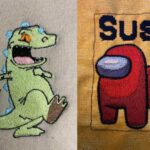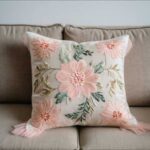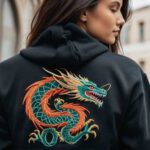Spandex or Elastane
A Beginners Guide To Stretch Fabric Embroidery
Introduction
Embroidering on stretch fabrics opens up a world of creative possibilities, but it also comes with unique challenges that require specialized knowledge and techniques. This guide delves into the intricacies of machine embroidery on stretch fabrics, offering comprehensive insights to help you navigate these challenges with confidence. From understanding the properties of stretch fabrics and selecting the right tools and materials to mastering essential techniques and troubleshooting common issues, this article equips you with the knowledge and skills to achieve professional quality results.
Whether you’re new to machine embroidery or looking to refine your craft, embracing these principles ensures that each stitch not only enhances your design but also withstands the demands of stretch fabrics. Explore the artistry of embroidery on stretch fabrics as we uncover the secrets to creating stunning, durable designs that elevate your projects to new heights.
Embroidery on stretch fabrics blends technical precision with creative expression, inviting you to experiment and innovate in every stitch. As you embark on this journey, embrace the challenges as opportunities to expand your skills and produce embroidered pieces that reflect your passion and expertise.
Understanding Stretch Fabrics
Stretch fabrics, such as spandex or elastane, are revolutionary materials in the world of fashion and performance wear. They are engineered to provide exceptional elasticity, allowing garments to stretch comfortably with the body while retaining their shape and offering support. These fabrics are predominantly made from synthetic fibers like spandex, also known as Lycra or elastane, often blended with natural fibers such as cotton or polyester. The primary characteristic of stretch fabrics is their ability to stretch significantly and revert to their original shape after stretching. This elasticity is crucial for form fitting garments that require flexibility and ease of movement.
Stretch fabrics have excellent recovery properties, bouncing back to their original form even after repeated use, which maintains the garment’s fit and comfort over time. Their durability and resistance to wear and tear make them suitable for activewear, sportswear, and other high performance applications. They are widely used in various industries due to their versatile properties, including activewear for yoga pants and compression garments, swimwear for their ability to withstand water exposure, and intimate apparel like bras and lingerie for their snug fit and comfort.
Different types of stretch fabrics cater to specific needs. Spandex, known for its exceptional stretch and recovery, is often blended with other fabrics to add elasticity. Lycra, a branded form of spandex, is particularly renowned for its high elasticity and resilience, making it ideal for sportswear and performance apparel.

Stretch cotton combines the natural comfort of cotton with added spandex for stretchability, perfect for casual and everyday wear. When selecting a stretch fabric for embroidery projects, consider factors like fabric blend, weight, and thickness. Opt for blends that include a percentage of spandex for stretch, and choose weights suitable for your embroidery design, lighter weights for easier embroidery and heavier weights for stronger needles and threads.
Understanding the unique properties and applications of stretch fabrics is essential for embroiderers looking to work with materials like spandex or elastane. By leveraging these insights, you can make informed decisions when selecting fabrics, preparing for embroidery, and achieving professional results in your projects.
Essential Tools and Materials
To achieve successful embroidery on stretch fabrics, having the right tools and materials is crucial. These elements ensure that your embroidery projects not only look great but also withstand the unique challenges posed by elastic fabrics.
Embroidering on stretch fabrics like spandex or elastane requires specialized techniques and materials due to their inherent elasticity. Without proper tools, such as appropriate stabilizers, needles, and threads, you may encounter issues such as fabric distortion, thread breakage, or uneven stitching.
The right stabilizer provides essential support to prevent stretching and puckering during embroidery, while suitable needles, like ballpoint needles, are designed to glide smoothly between the fibers without causing damage. High quality threads designed for stretch fabrics offer durability and flexibility, ensuring your designs maintain their integrity and appearance over time.
By investing in these essential tools and materials, you not only enhance the aesthetic appeal of your embroidery but also ensure longevity and durability, making your creations suitable for various applications from activewear to everyday apparel.
1. Stabilizers
Stabilizers are foundational to embroidery on stretch fabrics. They provide support and prevent the fabric from stretching or distorting during stitching. For stretch fabrics like spandex or elastane, which inherently have more stretch than woven fabrics, choosing the right stabilizer is critical. Consider using a cut away stabilizer for garments that require long term stability or a tear away stabilizer for projects where the backing will be removed after embroidery. Experimenting with different types of stabilizers can help you find the one that best suits your specific project needs.

2. Needles
Using the correct needles is essential when embroidering on stretch fabrics. For these materials, ballpoint needles are highly recommended. Unlike sharp needles designed for woven fabrics, ballpoint needles have a rounded tip that slides between the fibers of knit fabrics without damaging or breaking them. This helps prevent runs, holes, or skipped stitches, ensuring smooth and consistent embroidery results. Choose a needle size appropriate for the weight and thickness of your fabric, ensuring it penetrates without causing unnecessary tension or resistance.
3. Threads
Selecting the right threads for stretch fabric embroidery ensures both the aesthetic appeal and durability of your designs. Polyester embroidery threads are often preferred for their strength, colorfastness, and ability to withstand the stretch and recovery properties of elastic fabrics. These threads provide excellent coverage and a smooth finish, enhancing the overall quality of your embroidery. When working with spandex or elastane, consider using stretch friendly threads designed to accommodate the fabric’s elasticity. These specialized threads offer flexibility and resilience, minimizing the risk of breakage or thread tension issues during embroidery.
4. Hoops and Hooping Techniques
Proper hooping is crucial for achieving precise and professional embroidery results on stretch fabrics. When embroidering on spandex or elastane, consider using a hoop that matches the size and shape of your embroidery design. Ensure the fabric is taut and evenly stretched within the hoop, without excessive tension that could distort the fabric or cause puckering around the stitched design. For delicate or stretchy fabrics, alternative hooping methods such as floating the fabric on top of the stabilizer or using adhesive backing can help maintain fabric elasticity while ensuring secure placement during embroidery.
5. Machine Settings
Adjusting your embroidery machine settings is key to achieving optimal results on stretch fabrics. Begin by setting the machine for a slower stitching speed to minimize fabric stretching during embroidery. Adjust the tension settings to accommodate the elasticity of the fabric, too tight tension can cause puckering, while too loose tension may result in loose stitches or thread looping. Experiment with different stitch densities to find the balance that produces crisp, well defined embroidery without compromising fabric integrity. Regularly monitor and fine tune machine settings throughout the embroidery process to ensure consistent and professional quality results.
6. Additional Tools
In addition to the essentials mentioned above, consider investing in tools such as embroidery scissors for precise trimming of threads, marking pens for transferring designs onto stretch fabrics, and seam rippers for correcting mistakes without damaging delicate fibers. These tools enhance your embroidery experience and help you achieve meticulous craftsmanship on stretch fabrics.
By equipping yourself with the right tools and materials, you can confidently embark on embroidery projects using stretch fabrics like spandex or elastane. Understanding the role of stabilizers, needles, threads, hooping techniques, machine settings, and additional tools ensures that your embroidery endeavors are successful, allowing you to create beautiful and durable designs that showcase the unique properties of elastic fabrics.

Techniques for Preparation
Effective preparation is paramount when embroidering on stretch fabrics, as these materials present unique challenges that require careful handling and consideration. Begin by selecting the appropriate stabilizer tailored to the specific stretch and weight of the fabric. For stretch fabrics like spandex or elastane, which possess inherent elasticity, opt for a stabilizer that provides adequate support without compromising the fabric’s stretch and recovery properties. A cut away stabilizer offers robust reinforcement for garments requiring long term stability, while a tear away stabilizer facilitates easy removal post embroidery, ideal for delicate fabrics.
Choosing the right needle is equally crucial. Utilize ballpoint needles designed specifically for knit fabrics to prevent snagging or pulling during stitching. These needles feature a rounded tip that smoothly navigates between the fibers, minimizing the risk of damage while ensuring consistent stitch formation. Select a needle size appropriate to the fabric’s weight and thickness to maintain optimal tension and avoid unnecessary strain on the material.
Prepare your embroidery machine by adjusting settings conducive to stretch fabrics. Lower the stitching speed to reduce fabric stretching during embroidery, maintaining the fabric’s integrity and preventing distortion. Fine tune tension settings to accommodate the fabric’s elasticity; optimal tension prevents puckering or thread breakage, ensuring precise and durable embroidery results. Experiment with stitch densities to achieve crisp, well defined designs that highlight the fabric’s natural drape and texture.
Mastering proper hooping techniques enhances embroidery precision and fabric stability. Choose a hoop size that matches your design’s dimensions, ensuring the fabric is securely taut without excessive tension that could distort or misshape the embroidery. When hooping stretch fabrics, consider alternative methods such as floating the fabric above the stabilizer or utilizing adhesive backing to preserve elasticity while securely anchoring the material. These techniques prevent fabric distortion and maintain stretch, crucial for achieving professional quality embroidery.
Pretreat your fabric before embroidering by washing and drying to remove any sizing, residues, or wrinkles that may affect stitch quality. Use fabric safe marking tools to accurately outline design placement on stretch fabrics, ensuring precise embroidery alignment without leaving permanent marks. By meticulously preparing your materials and equipment, you establish a solid foundation for successful embroidery on stretch fabrics, enabling you to create intricate and durable designs with confidence and precision.
Stretch Fabric Embroidery Tips and Tricks
Embroidering on stretch fabrics presents unique challenges and opportunities for machine embroidery enthusiasts. To achieve professional quality results, mastering specific techniques and understanding the nuances of materials and equipment are essential. The following tips and tricks delve into the intricacies of embroidering on stretch fabrics, offering comprehensive guidance to enhance your embroidery skills and ensure successful outcomes. Whether you’re working on activewear, swimwear, or other stretchy garments, these insights will empower you to tackle projects with confidence, navigating through potential pitfalls while maximizing the aesthetic and functional potential of your embroidery.

Embroidery on stretch fabrics requires careful consideration of design, stabilizer use, thread selection, and machine settings. Each element plays a crucial role in achieving durable, aesthetically pleasing results that withstand the fabric’s natural elasticity. By honing your techniques and employing strategic approaches outlined in the following sections, you’ll be equipped to overcome challenges and unleash creativity in your embroidery endeavors. Let’s delve into these essential tips and tricks that will elevate your machine embroidery on stretch fabrics to new heights of precision and artistry.
• Design Selection
Choosing the right design is crucial for successful embroidery on stretch fabrics. Opt for designs that complement the fabric’s stretch properties. Designs with fewer dense stitches are ideal to prevent puckering and distortion. Consider the garment’s natural drape and movement when positioning your design. This ensures that the embroidery enhances comfort and functionality without compromising the fabric’s elasticity. Avoid intricate designs with very fine details that may not translate well onto stretch fabrics, as they can become lost or distorted during the embroidery process.
• Stabilizer Use
Using a stabilizer is essential for achieving crisp and defined embroidery on stretch fabrics. A water soluble stabilizer placed on top of the fabric acts as a barrier, preventing stitches from sinking into the fibers. This is particularly beneficial on textured or uneven surfaces where stitches might otherwise get lost or appear uneven. For stretch fabrics, consider using cut away stabilizers for added support, especially in areas with dense stitching. Tear away stabilizers are suitable for lighter designs or when minimal stabilizer residue is desired on the fabric.
• Technique Exploration
Experiment with different techniques such as appliqué or quilting to enhance the texture and durability of embroidery on stretch fabrics. Appliqué involves layering fabric pieces to create designs, reducing the strain on the stretch fabric while adding dimension. Quilting techniques can be adapted for embroidery by using stitch patterns that complement the fabric’s stretch. These methods not only add visual interest but also reinforce the fabric, making the embroidery more durable over time. Explore combination techniques where appliqué is combined with traditional embroidery to achieve intricate and unique designs.
• Thread Selection
Choosing the right thread is crucial for successful embroidery on stretch fabrics. Polyester embroidery threads are preferred due to their strength and elasticity, which helps them withstand the stretching and movement of the fabric without breaking or losing tension. Rayon threads are also popular for their lustrous finish, but they may not provide the same level of durability on stretch fabrics. Match thread colors closely to the fabric for seamless integration, ensuring the embroidery complements the garment’s overall look. Consider using bobbin threads that match the top thread to maintain consistency in tension and appearance.
• Hoop Placement and Tension
Proper hoop placement and tension are key to preventing fabric distortion during embroidery. Use a hoop that matches the size and shape of your design, ensuring the fabric is evenly stretched but not overly tensioned. This prevents puckering and maintains the fabric’s natural stretch. For large or complex designs, consider using multiple smaller hoops or repositioning the fabric as needed to maintain tension throughout the embroidery process. Experiment with different hoop types, such as magnetic or adhesive hoops, to find the best option for your specific project and fabric type.
• Needle Maintenance
Regularly changing needles is essential for preventing fabric damage and maintaining embroidery quality on stretch fabrics. Dull or worn needles can snag the fabric, causing pulls or tears. Use a fresh needle for each project or after every 8 10 hours of embroidery to ensure sharpness and precision stitching. Choose needles specifically designed for embroidery on stretch fabrics, such as ballpoint or stretch needles, which have rounded tips that slide between the fabric fibers without causing damage.

• Test Stitching
Before embroidering on your main project, always conduct test stitches on a scrap piece of fabric. This allows you to fine tune settings such as stitch density, tension, and embroidery speed. It also helps you assess how the design interacts with the stretch fabric, ensuring the final embroidery is of high quality and meets your expectations. Adjust thread tensions and needle types as needed to achieve smooth and even stitches without puckering or thread breakage.
• Fabric Handling
Handle stretch fabrics with care to avoid stretching or distorting the material during hooping and embroidery. Gently stretch the fabric when hooping to ensure it’s taut but not overly stretched, which can lead to puckering or misalignment of the design. Use fabric clips or pins to secure the fabric in the hoop, ensuring it remains flat and smooth throughout the embroidery process. Avoid pulling or tugging on the fabric while stitching, as this can cause uneven tension and affect the overall quality of the embroidery.
• Machine Maintenance
Regularly cleaning and lubricating your embroidery machine is essential for smooth operation and optimal embroidery results on stretch fabrics. Clean the bobbin case, feed dogs, and needle plate regularly to remove lint, dust, and thread residue that can affect stitch quality. Lubricate moving parts according to the manufacturer’s guidelines to reduce friction and ensure consistent stitching. Check and adjust thread tensions, bobbin tension, and needle alignment as part of your regular maintenance routine to prevent thread breaks, stitching inconsistencies, or machine malfunctions during embroidery.
• Embroidery Placement
Carefully consider the placement of your embroidery design on the garment. Avoid stitching directly over seams or areas that will stretch significantly during wear, as this can compromise the integrity of the embroidery and the comfort of the garment. Position the design strategically to enhance the garment’s aesthetic appeal and functional usability. Use templates or fabric markers to outline design placement before hooping to ensure accurate positioning and alignment. Test the placement on a scrap piece of fabric to verify the design’s size and placement before embroidering on the main garment.
• Layering Techniques
For intricate or multi colored designs, consider using layering techniques to achieve depth and detail without overstressing the stretch fabric. Embroidering different elements of the design separately and then assembling them can reduce fabric tension and ensure each component of the embroidery remains crisp and well defined. This approach also allows for greater creativity and customization in your embroidery projects. Use fusible webbing or adhesive stabilizers to secure appliqué pieces in place before stitching, ensuring they remain flat and smooth throughout the embroidery process.
• Patience and Practice
Achieving high quality embroidery on stretch fabrics requires patience and practice. Don’t hesitate to experiment with different techniques, settings, and materials to find what works best for your specific project and fabric type. Each project is an opportunity to refine your skills and develop a deeper understanding of how to achieve professional quality results in machine embroidery. Take the time to practice new techniques on scrap fabric before applying them to your main project, allowing you to refine your approach and achieve the desired outcome with confidence.

By incorporating these tailored tips and tricks into your machine embroidery process on stretch fabrics, you can confidently achieve intricate and durable designs, showcasing their unique qualities while maintaining professional quality results.
Troubleshooting and Common Issues
Embroidering on stretch fabrics demands a nuanced approach to overcome specific challenges and ensure impeccable results. Understanding and addressing common issues such as puckering, thread breakage, design distortion, needle breakage, bobbin tension issues, and hooping problems are essential for achieving professional quality embroidery on stretch fabrics.
Puckering: Puckering is a common concern in machine embroidery on stretch fabrics, where the fabric gathers around the embroidery, leading to an uneven or wrinkled appearance. This issue often arises due to inadequate stabilizer support or incorrect tension settings. To prevent puckering, start by selecting the appropriate stabilizer for stretch fabrics, cut away stabilizers provide robust support for dense designs, while tear away stabilizers are suitable for lighter applications.
Adjust your machine’s tension settings carefully; for stretch fabrics, a slightly looser tension may be necessary to accommodate the fabric’s natural elasticity while maintaining stitch integrity. Conducting test stitches on scrap fabric before starting your project allows you to fine tune tension settings and identify potential issues early on, ensuring smooth stitching and minimizing puckering throughout your embroidery project.
Thread Breakage: Thread breakage can disrupt the embroidery process and compromise the final appearance of your design. It often occurs due to using old or low quality threads, improper needle selection, or excessive tension. Opt for high quality polyester or rayon threads specifically formulated for stretch fabrics to minimize breakage. Regularly replace needles to prevent dullness, which can cause snagging and thread breaks. Conduct thorough test stitches to adjust tension settings and needle types according to your fabric’s stretch and the complexity of your design.
Design Distortion: Distortion of the embroidery design during stitching can occur if the fabric stretches excessively in the hoop or if the design isn’t properly stabilized. To mitigate design distortion, carefully stretch the fabric when hooping to achieve a firm yet gentle tension. Experiment with different hooping techniques and stabilizer combinations, such as using multiple layers of stabilizer or adhesive sprays, to minimize fabric movement during embroidery. Adjusting machine settings gradually and conducting test stitches allow you to find the optimal setup for each project, ensuring precise and professional results.
Needle Breakage and Snags: Needle breakage or snags can occur when embroidering on stretch fabrics, especially if the needle is dull or not suited for the fabric type. Use needles specifically designed for stretch fabrics, such as ballpoint or stretch needles, which have rounded tips that slide between fabric fibers without causing damage. Ensure needles are changed regularly to maintain sharpness and prevent snags that can distort the fabric or affect stitch quality.

Bobbin Tension Issues: Uneven bobbin tension can lead to visible bobbin thread on the top of the embroidery or inconsistent stitching. Adjust the bobbin tension according to your machine’s manual and conduct test stitches to ensure balanced tension between the top and bobbin threads. Properly wound and inserted bobbins also contribute to smooth stitching and prevent thread jams or breaks during embroidery.
Hooping Problems: Hooping problems can significantly impact embroidery quality, especially with stretch fabrics. Incorrect hooping can lead to uneven tension across the fabric, causing distortion or misalignment of the design. Ensure the fabric is evenly stretched and taut within the hoop, avoiding excessive tension that could stretch the fabric beyond its natural elasticity. Experiment with different hooping techniques, such as adjusting hoop tightness and using additional stabilizers, to find the optimal setup for each project. Proper hooping techniques help maintain fabric stability during stitching, resulting in crisp and precise embroidery on stretch fabrics.
By addressing these common challenges through meticulous troubleshooting and thoughtful adjustments, you can elevate your machine embroidery skills on stretch fabrics. Each troubleshooting opportunity presents a chance to refine your techniques and achieve flawless embroidery outcomes, showcasing your expertise and creativity in every stitch.
Conclusion
Mastering machine embroidery on stretch fabrics requires attention to detail, thoughtful preparation, and adept troubleshooting skills. Throughout this guide, we’ve explored essential techniques, from selecting the right tools and materials to troubleshooting common issues like puckering, thread breakage, and design distortion. Understanding the unique properties of stretch fabrics and employing appropriate methods, such as adjusting tension settings and experimenting with hooping techniques, ensures smooth and professional results.
By continuously refining your skills through practice and adaptation, you can confidently tackle embroidery projects on stretch fabrics, producing intricate designs that showcase both precision and creativity. Whether you’re a beginner or seasoned embroiderer, these insights empower you to elevate your craft and achieve exceptional embroidery outcomes that captivate and inspire.
Embroidery on stretch fabrics presents a rewarding challenge, combining technical proficiency with artistic expression. Embrace each project as an opportunity to refine your techniques and explore the limitless possibilities of machine embroidery. With a foundation built on knowledge, patience, and innovation, your journey in mastering embroidery on stretch fabrics promises growth and fulfillment in every stitch.
Now that you have read through this article, feel free to SHOP for products we have created. If you are looking for something special which isn’t in our store, feel free to contact us.














